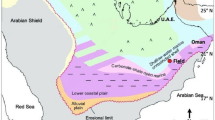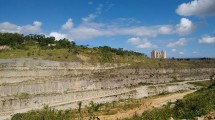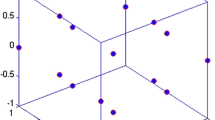Abstract
During 2003–2006, a pilot project of alternating water and CO2 injection was performed on a limited part of the Upper Miocene sandstone oil reservoir of the Ivanić Field. During the test period oil and gas recovery was significantly increased. Additionally 4,440 m3 of oil and 2.26 × 106 m3 of gas were produced. It has initiated further modelling of sandstone reservoirs in the Ivanić Field in order to calculate volumes available for CO2 injection for the purpose of increasing hydrocarbon production from depleted sandstone reservoirs in the entire Croatian part of the Pannonian Basin System. In the first phase, modelling was based on results of laboratory testing on the core samples. It considered applying analogies with world-known projects of CO2 subsurface storage and its usage to enhance hydrocarbon production. In the second phase, reservoir variables were analysed by variograms and subsequently mapped in order to reach lithological heterogeneities and to determine reliable average values of reservoir volumes. Data on porosity, depth and reservoir thickness for the “Gamma 3” and the “Gamma 4” reservoirs, are mapped by the ordinary kriging technique. Calculated volume of CO2 expressed at standard condition which can be injected in the main reservoirs of the Ivanić Field at near miscible conditions is above 15.5 billion m3.









Similar content being viewed by others
References
Bachu S, Shaw JC (2004) CO2 storage in oil and gas reservoirs in western Canada: effect of aquifers, potential for CO2 flood enhanced oil recovery and practical capacity. In: Proceedings of the 7th international conference of greenhouse gas control technologies, Vancouver, 5–9 Sept 2004
Balić D, Velić J, Malvić T (2008) Selection oft he most appropriate interpolation method for sandstone reservoirs in the Kloštar oil and gas field. Geol Croat 61(1):23–75
Bennaceur K, Monea M, Sakurai S, Gupta N, Ramakrishnan TS, Whittaker S, Randen T (2004) CO2 capture and storage—a solution within. Oilfield Rev 16(3):44–61
Böttcher N, Taron J, Kolditz O, Park C-H, Liedl R (2012) Evaluation of thermal equations of state for CO2 in numerical simulations. Environ Earth Sci 67(2):481–495
Brown K, Jazrawi W, Moberg R, Wilson M (2004) Role of enhanced oil recovery in carbon sequestration: the Weyburn monitoring project, a case study. http://www.netl.doe.gov/publications/proceedings/01/carbon_seq/2a1.pdf. Accessed 18 May 2012
Chadwick RA, Zweigel P, Gregersen U, Kirby GA, Holloway S, Johannessen PN (2002) Geological characterisation of CO2 storage sites: lessons from sleeper, northern North Sea, paper B1–B3. In: Proceedings of the 6th international conference on greenhouse gas control technologies, Kyoto, 1–4 Oct 2002
Doughty C, Pruess K (2004) Modeling supercritical carbon dioxide injection in heterogeneous porous media. Vadose Zone J 3(3):837–847
Goričnik B, Domitrović D (2003) Laboratorijska istraživanja primjenjivosti CO2 procesa na naftnim poljima u Hrvatskoj [Laboratory research of CO2 EOR potential in the mature oilfields in the Republic of Croatia]. Naftaplin 1:5–12
Han WS, McPherson BJ (2009) Optimizing geologic CO2 sequestration by injection in deep saline formations below oil reservoirs. Energy Convers Manag 50(10):2570–2582
Hernitz Z, Velić J, Kranjec V, Najdenovski J (1980) Prikaz diferencijalnih i maloamplitudnih struktura s primjerima iz Savske potoline [Presentation of differential low-amplitude structures with examples from the Sava Depression (Pannonian Basin)]. Nafta 7(8):399–409
Kühn M, Förster A, Grossmann J, Meyer R, Pilz P, Reinicke K, Schaefer D, Tesmer M, Wendel H (2011) CLEAN—Large-scale CO2 storage for enhanced gas recovery in a depleted German gasfield. American Geophysical Union, Fall Meeting 2011, abstract #GC51A-0913
Malvić T (2008) Production of porosity map by kriging in sandstone reservoirs, case study from the Sava Depression. Kartografija i Geoinformacije 9:12–19
Malvić T (2012) Review of Miocene shallow marine and lacustrine depositional environments in Northern Croatia. Geol Q 56(3):493–504
Malvić T, Đureković M (2003) Application of the methods: inverse distance weighting, ordinary kriging and collocated cokriging in porosity evaluation, and comparison of results on the Beničanci and Stari Gradac fields in Croatia. Nafta 54(9):331–340
Malvić T, Velić J (2011) Neogene tectonics in Croatian part of the Pannonian Basin and reflectance in hydrocarbon accumulations. In: Schattner U (ed) New frontiers in tectonic research: at the midst of plate convergence. Intech, Rijeka, pp 215–238
Martens S, Kempka T, Liebscher A, Lüth S, Möller F, Myrttinen A, Norden B, Schmidt-Hattenberger C, Zimmer M, Kühn M, The Ketzin Group (2012) Europe’s longest-operating on-shore CO2 storage site at Ketzin, Germany: a progress report after three years of injection. Environ Earth Sci. doi:10.1007/s12665-012-1672-5 (special issue)
Novak K, Malvić T, Simon K (2013) Increased hydrocarbon recovery and CO2 management, a Croatian example. Environ Earth Sci 68:1187–1197. doi:10.1007/s12665-012-1819-4
Novosel D (2005) Rezultati projekta pokusnog istiskivanja nafte utiskivanjem ugljičnog dioksida na Naftnom polju Ivanić [The project results of test oil replacement by carbon dioxide on the Ivanić oil field]. Naftaplin 1:51–60
Novosel D (2009) Učinak ugljičnog dioksida u tercijarnoj fazi iskorištavanja naftnih ležisšta polja Ivanić [The effect of the carbon dioxide on the tertiary exploration phase at the Ivanić oil field—in Croatian], Dissertation. University of Zagreb, Zagreb
Pannatier Y (1996) Variowin: software for spatial data analysis in 2D. Springer, Netherlands, p 91
Perić M, Kovač S (2003) Simulacijska studija procesa povećanja iscrpka nafte (EOR-procesa) istiskivanjem ugljik-dioksidom primjenom višekomponentnog modela COMP III [Simulation study of enhanced oil recovery process by CO2 injection applying a multi-component COMP III]. Naftaplin 1:13–25
Sečen J (2006) Metode povećanja iscrpka [Enhance oil recovery methods], 1st edn. INA-Naftaplin, Zagreb, p 608
Singh AK, Baumann G, Henninges J, Görke U-J, Kolditz O (2012) Numerical analysis of thermal effects during carbon dioxide injection with enhanced gas recovery: a theoretical case study for the Altmark gas field. Environ Earth Sci 67(2):497–509
Thorade M, Saadat A (2013) Partial derivatives of thermodynamic state properties for dynamic simulation. Environ Earth Sci. doi:10.1007/s12665-013-2394-z
Vrbanac B, Velić J, Malvić T (2010) Sedimentation of deep-water turbidites in main and marginal basins in the SW part of the Pannonian Basin. Geol Carpath 61(1):55–69
Author information
Authors and Affiliations
Corresponding author
Rights and permissions
About this article
Cite this article
Novak, K., Malvić, T., Velić, J. et al. Increased hydrocarbon recovery and CO2 storage in Neogene sandstones, a Croatian example: part II. Environ Earth Sci 71, 3641–3653 (2014). https://doi.org/10.1007/s12665-013-2756-6
Received:
Accepted:
Published:
Issue Date:
DOI: https://doi.org/10.1007/s12665-013-2756-6




